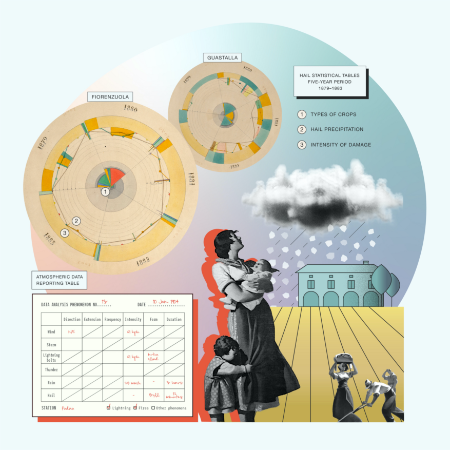When cannons fired at hail
Romentino (Novara)
15th September 1914
Francesco Paglino, Class 4, Scuola Italia
Theme: “My summer”
Discussion:
I spent the summer working in the countryside.
Dad and Mum are farmers. Summer is the time when they work the most.
At the farm we have animals: chickens, pigs, a few cows and a bull, plus Giufà the dog who guards us, watches the sheep, and plays with me.
My family grows rice and corn, the same as in all the countryside in this area around the city of Novara. I often go into the fields with my dad and he lets me hold the reins of the horses pulling the cart.
Often when we’re in the ricefields and he’s working, I go fishing for frogs on the edge of the ricefield and I have fun catching the water snakes, they’re dark and slimy, but then I always let them go.
It rained a lot this summer – Dad says more than usual – and the rain often turned into hail. The air would get cold like in winter and ice would start falling from the sky.
In August, on the evening of the feast of Saint Rocco, hailstones came down that were the size of pinecones.
Half of the crop was ruined.
It was a really bad night. Dad tried to save the corn but half of it was destroyed, Mum was crying in the house, and I stayed with Giufà in the kitchen, watching the world coming down.
The next day, Dad went to buy the cannons.
Hail cannons look like ice cream cones, only they’re very big and instead of having cream or chocolate on top, they’re empty, and they fire shots into the sky, so that the hail doesn’t come down anymore. I think they make holes in the clouds.
When they’re working, they fire lots of shots one after the other and make a heck of a noise.
Dad is convinced that this method will work, but Mum doesn’t agree at all. They fought a lot about it, until Mum persuaded Dad to talk to an insurance agent. The insurance agent is a man you give money to so that if it hails, he pays you for the ruined crop, if I’ve understood right. I didn’t know something like that existed.
He was a smartly dressed gentleman who spoke very well and, at one point, he opened a colourful map on the kitchen table, full of numbers that show how much hail falls in each different place on the map. It’s a map his company drew based on the information given by him and his colleagues. I’d never seen anything like it. It looked like a treasure map.
I’d have liked to keep it and hang it up in my room, but he told me that he needed it for work. But he promised that when the company gives him a new one next year, he’ll give me this one.
Dad might have decided to insure the fields, but he’s decided to keep using the cannons too, which makes me happy, because every time they start firing, it feels like New Year’s Eve.
And that was my summer.
HISTORY

One of the most popular “systems” among attempts at active defence is that of hail cannons. It is an ancient method, continually resurrected in new forms, supposedly already in use at the beginning of the 20th century. Generali was involved in the experimental campaign of anti-hail shots through contributions to the expenses the policyholders incurred for the equipment, as well as a discount on the premiums of the policies underwritten.
Through Generali’s efforts, the first Italian insurance policy against hail damage was issued in 1836.
In the nineteenth century, insurance against hail damage was a new and risky sector, because of the difficulty in setting appropriate rates and premiums due to a lack of data. Generali therefore engaged in its own data collection work, carried out in the field by its agency network, which not only made the hail sector less uncertain, but also advanced the study of atmospheric phenomena, with the cooperation of the Central Meteorological Office in Rome from 1881. In 1890, after decades of experience in the sector, Generali entrusted the insurance of the sector to its subsidiary in Milan: Anonima Grandine.
